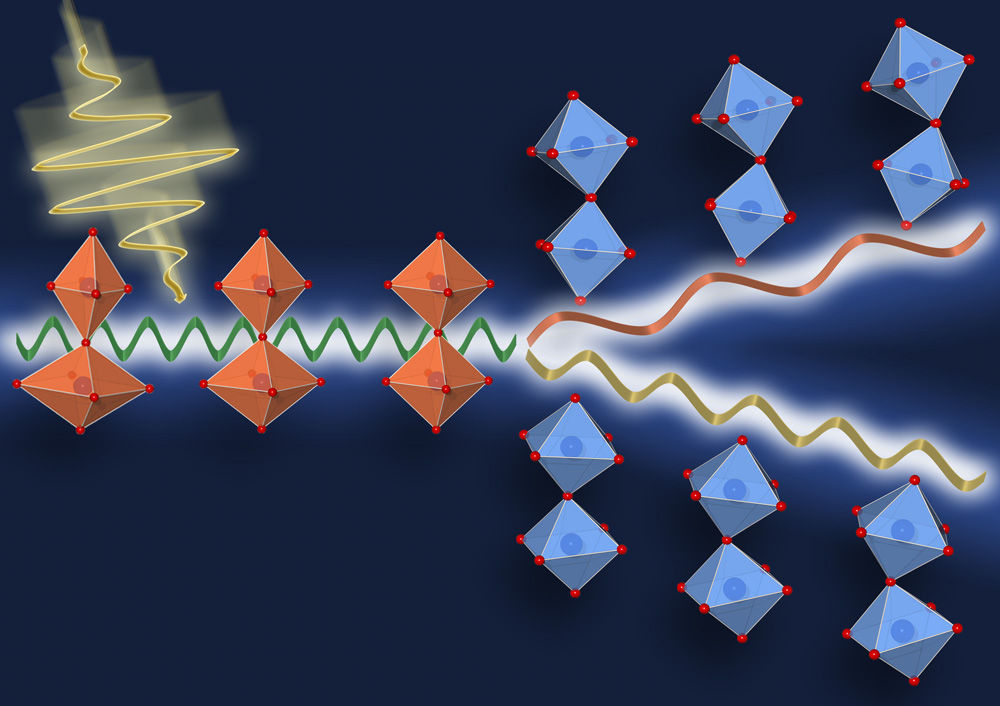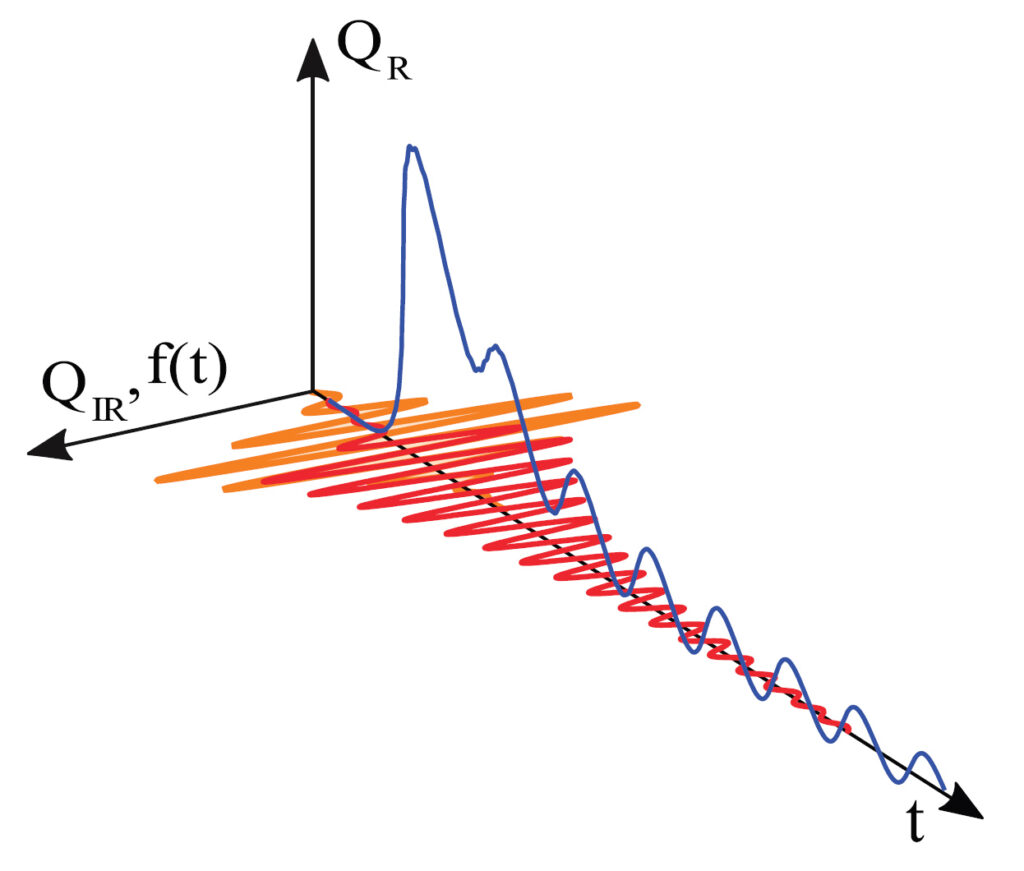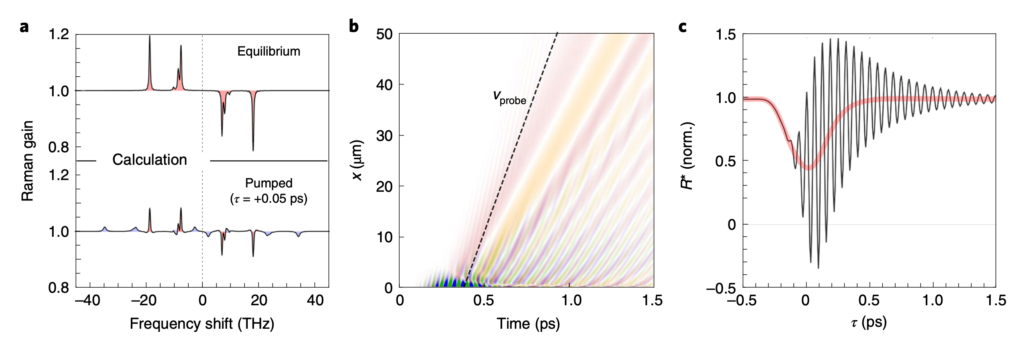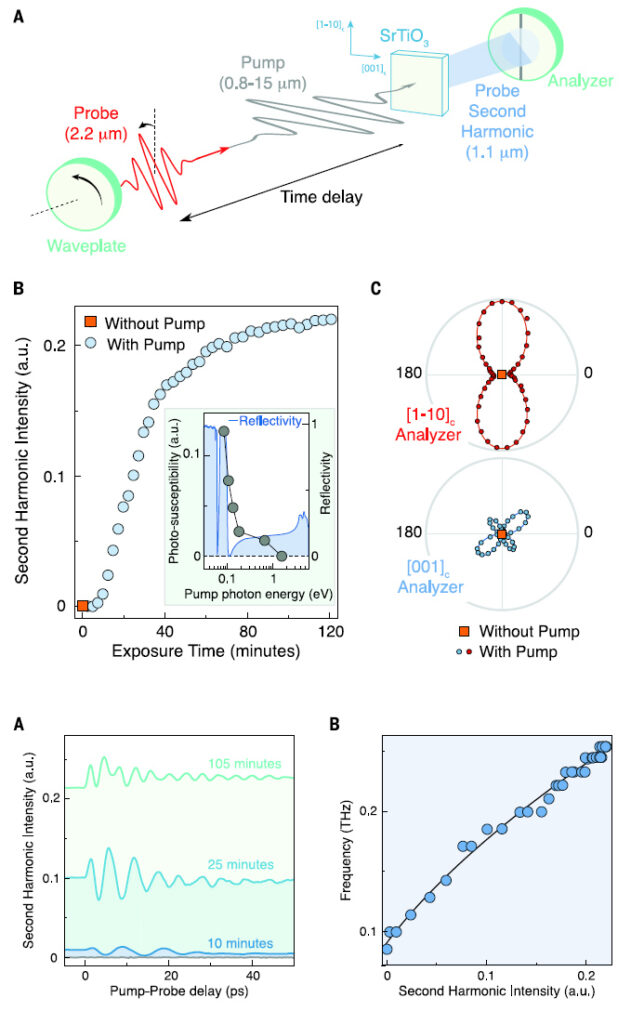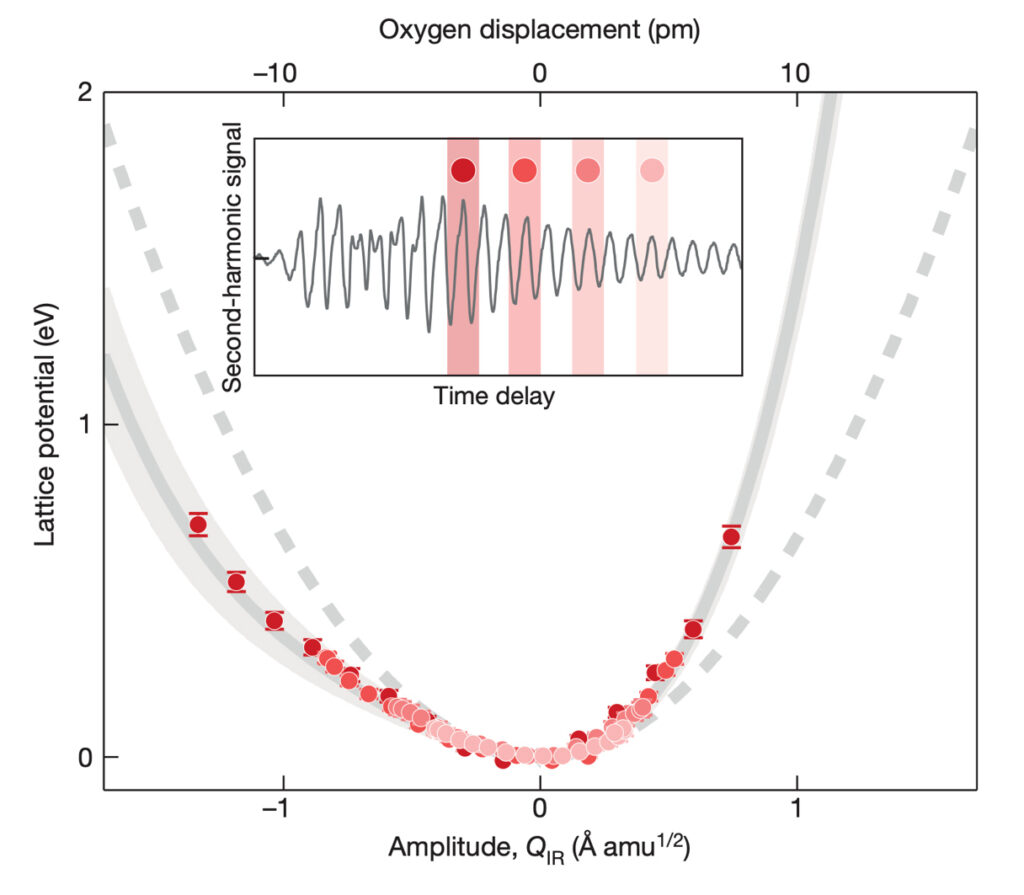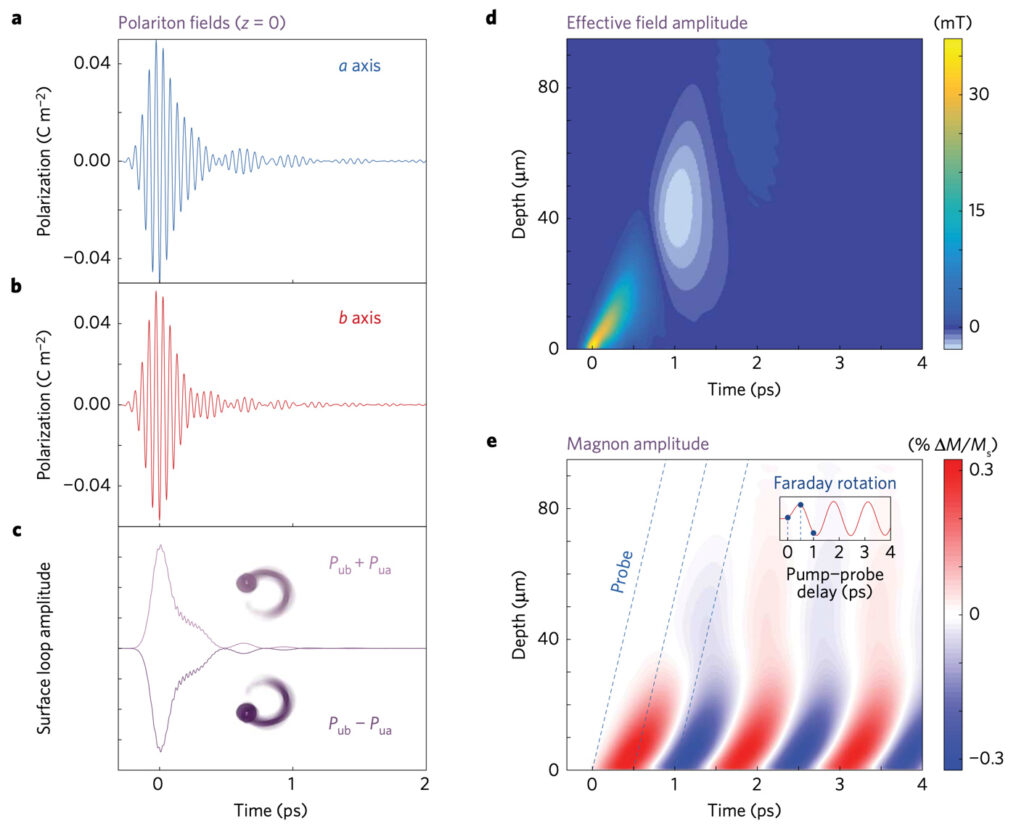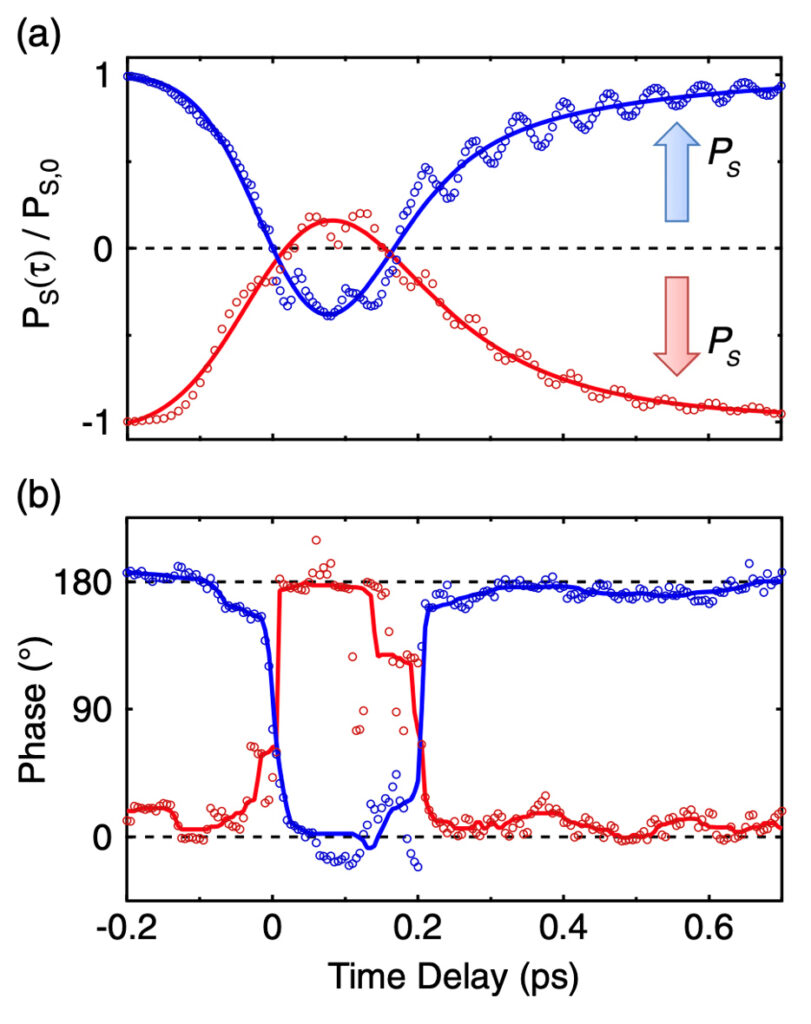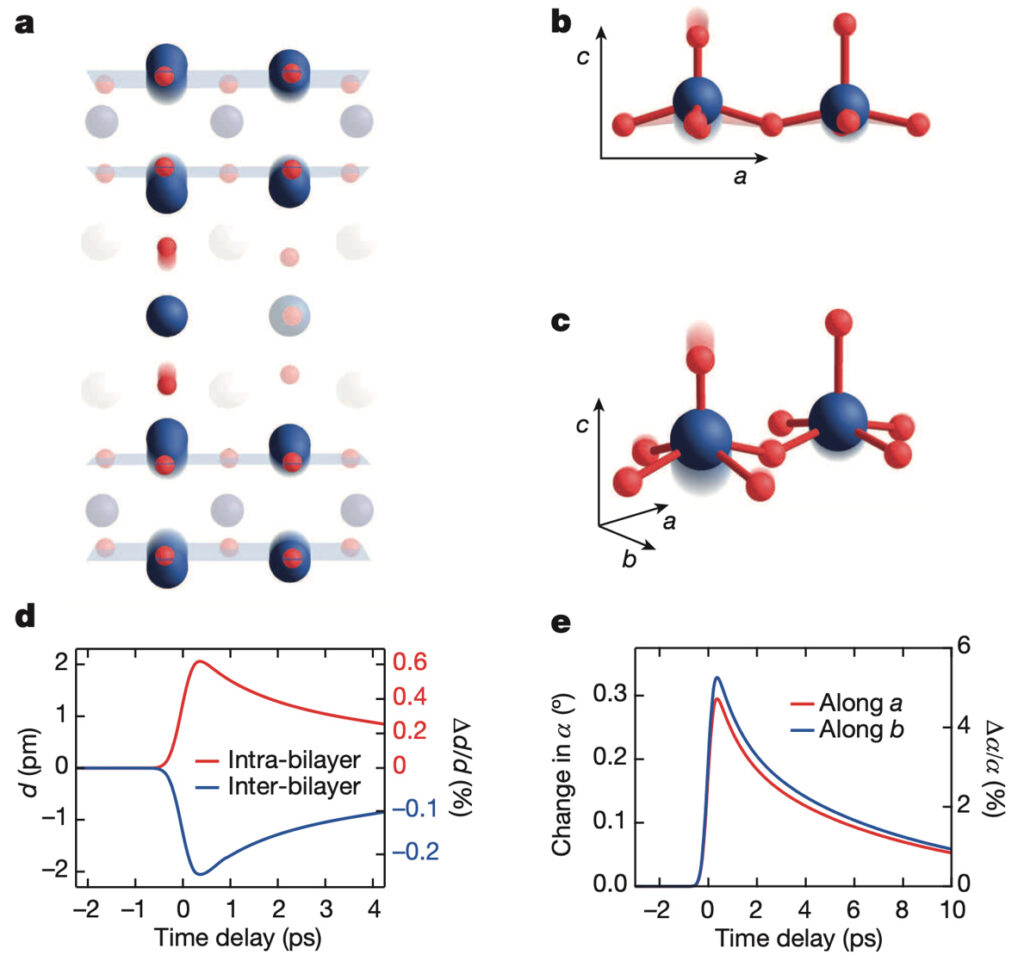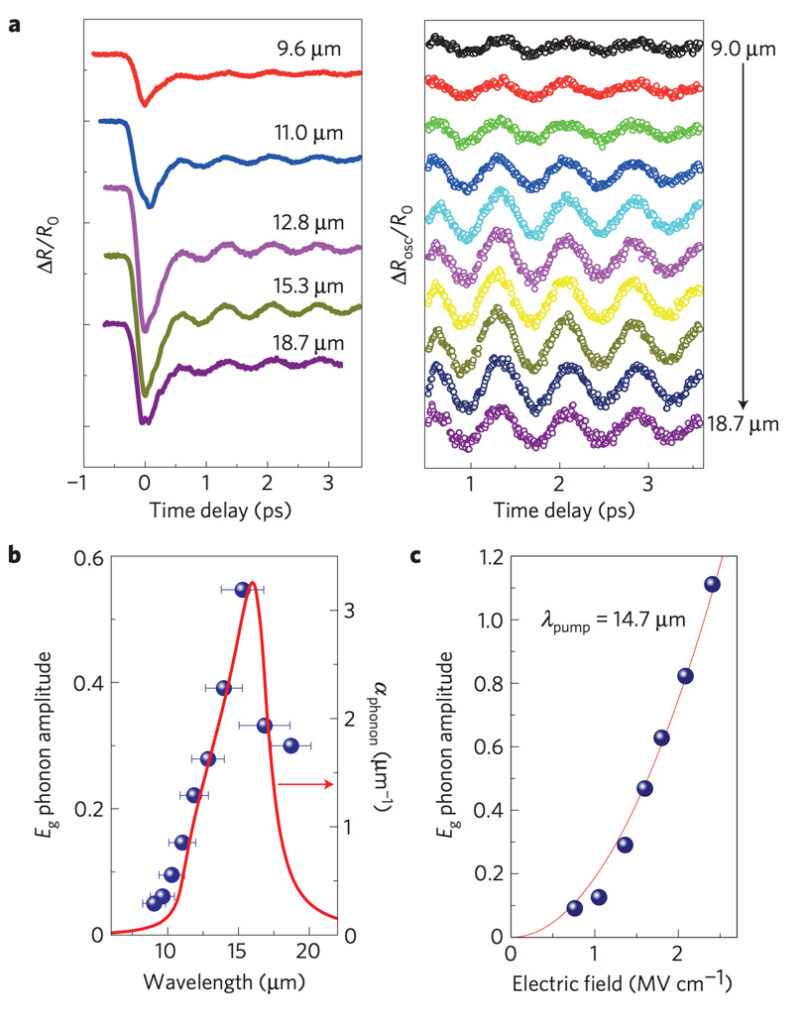Structural control, for example through material synthesis, pressure application or strain engineering, is an established technique to manipulate the electronic and magnetic phases of quantum materials statically. The application of intense light pulses, on the other hand, allows to distort the crystal structure of a solid in a dynamical fashion on time scales down to the femtosecond regime. Nonlinear phononics makes use of tailored light fields at mid-infrared and THz frequencies to resonantly drive infrared-active optical phonons to large amplitudes. In this case, anharmonicities of the crystal lattice induce symmetry breaking atomic structures away from equilibrium with designed electronic or magnetic functionality. We successfully apply nonlinear phononics to control ferroelectric polarization, magnetic order or high-temperature superconductivity.
Reviews
Engineering crystal structures with light
A. S. Disa, T. F. Nova and A. Cavalleri
Nature Physics, 17, 1087-1092 (2021)
Abstract
The crystal structure of a solid largely dictates its electronic, optical and mechanical properties. Indeed, much of the exploration of quantum materials in recent years including the discovery of new phases and phenomena in correlated, topological and two-dimensional materials—has been based on the ability to rationally control crystal structures through materials synthesis, strain engineering or heterostructuring of van der Waals bonded materials. These static approaches, while enormously powerful, are limited by thermodynamic and elastic constraints. An emerging avenue of study has focused on extending such structural control to the dynamical regime by using resonant laser pulses to drive vibrational modes in a crystal. This paradigm of ‘nonlinear phononics’ provides a basis for rationally designing the structure and symmetry of crystals with light, allowing for the manipulation of functional properties at high speed and, in many instances, beyond what may be possible in equilibrium. Here we provide an overview of the developments in this field, discussing the theory, applications and future prospects of optical crystal structure engineering.
Non-equilibrium control of complex solids by nonlinear phononics
R. Mankowsky, M. Först and A. Cavalleri
Reports on Progress in Physics, 79, 6 (2016)
Abstract
We review some recent advances in the use of optical fields at terahertz frequencies to drive the lattice of complex materials. We will focus on the control of low energy collective properties of solids, which emerge on average when a high frequency vibration is driven and a new crystal structure induced. We first discuss the fundamentals of these lattice rearrangements, based on how anharmonic mode coupling transforms an oscillatory motion into a quasi-static deformation of the crystal structure. We then discuss experiments, in which selectively changing a bond angle turns an insulator into a metal, accompanied by changes in charge, orbital and magnetic order. We then address the case of light induced non-equilibrium superconductivity, a mysterious phenomenon observed in some cuprates and molecular materials when certain lattice vibrations are driven. Finally, we show that the dynamics of electronic and magnetic phase transitions in complex-oxide heterostructures follow distinctly new physical pathways in case of the resonant excitation of a substrate vibrational mode.
Key publications
Quenched lattice fluctuations in optically driven SrTiO3
M. Fechner, M. Först, G. Orenstein, V. Krapivin, A. Disa, M. Buzzi, A. von Hoegen, G. de la Pena, Q. L. Nguyen, R. Mankowsky, M. Sander, H. Lemke, Y. Deng, M. Trigo, A. Cavalleri
Nature Materials, 23, 363–368 (2024)
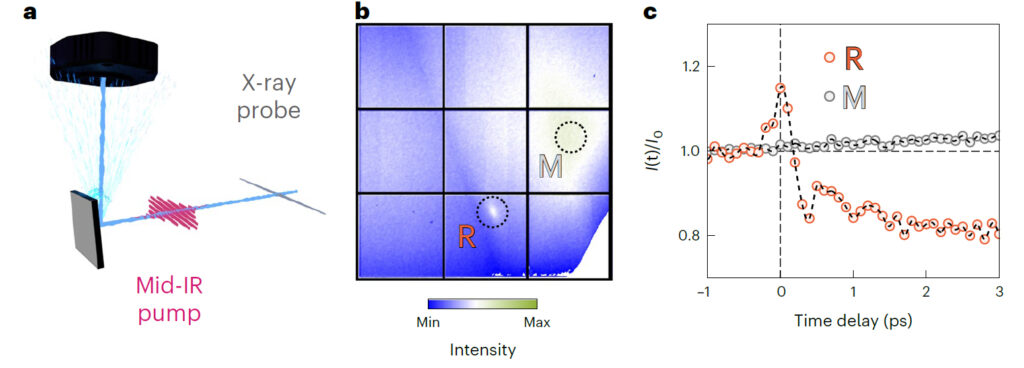
Abstract:
Crystal lattice fluctuations, which are known to influence phase transitions of quantum materials in equilibrium, are also expected to determine the dynamics of light-induced phase changes. However, they have only rarely been explored in these dynamical settings. Here we study the time evolution of lattice fluctuations in the quantum paraelectric SrTiO3, in which mid-infrared drives have been shown to induce a metastable ferroelectric state. Crucial in these physics is the competition between polar instabilities and antiferrodistortive rotations, which in equilibrium frustrate the formation of long-range ferroelectricity. We make use of high-intensity mid-infrared optical pulses to resonantly drive the Ti–O-stretching mode at 17 THz, and we measure the resulting change in lattice fluctuations using time-resolved X-ray diffuse scattering at a free-electron laser. After a prompt increase, we observe a long-lived quench in R-point antiferrodistortive lattice fluctuations. Their enhancement and reduction are theoretically explained by considering the fourth-order nonlinear phononic interactions to the driven optical phonon and third-order coupling to lattice strain, respectively. These observations provide a number of testable hypotheses for the physics of light-induced ferroelectricity.
Nonlocal nonlinear phononics
M. Henstridge, M. Först, E. Rowe, M. Fechner, A. Cavalleri
Nature Physics, 18, 457–461 (2022)
Abstract
Nonlinear phononics relies on the resonant optical excitation of infrared-active lattice vibrations to induce targeted structural deformations in solids. This form of dynamical crystal structure design has been applied to control the functional properties of many complex solids, including magnetic materials, superconductors and ferroelectrics. However, phononics has so far been restricted to protocols in which structural deformations occur within the optically excited volume, sometimes resulting in unwanted heating. Here, we extend nonlinear phononics to propagating polaritons, spatially separating the functional response from the optical drive. We use mid-infrared optical pulses to resonantly drive a phonon at the surface of ferroelectric LiNbO3. Time-resolved stimulated Raman scattering reveals that the ferroelectric polarization is reduced over the entire 50 μm depth of the sample, far beyond the micrometre depth of the evanescent phonon field. We attribute this effect to the anharmonic coupling between the driven mode and a polariton that propagates into the material. For high excitation amplitudes, we reach a regime in which the ferroelectric polarization is reversed, as revealed by a sign change in the Raman tensor coefficients of all the polar modes.
Polarizing an antiferromagnet by optical engineering of the crystal field
A. S. Disa, M. Fechner, T. F. Nova, B. Liu, M. Först, D. Prabhakaran, P. G. Radaelli, A. Cavalleri
Nature Physics 16, 937–941 (2020)
Abstract
Strain engineering is widely used to manipulate the electronic and magnetic properties of complex materials. For example, the piezomagnetic effect provides an attractive route to control magnetism with strain. In this effect, the staggered spin structure of an antiferromagnet is decompensated by breaking the crystal field symmetry, which induces a ferrimagnetic polarization. Piezomagnetism is especially appealing because, unlike magnetostriction, it couples strain and magnetization at linear order, and allows for bi-directional control suitable for memory and spintronics applications. However, its use in functional devices has so far been hindered by the slow speed and large uniaxial strains required. Here we show that the essential features of piezomagnetism can be reproduced with optical phonons alone, which can be driven by light to large amplitudes without changing the volume and hence beyond the elastic limits of the material. We exploit nonlinear, three-phonon mixing to induce the desired crystal field distortions in the antiferromagnet CoF2. Through this effect, we generate a ferrimagnetic moment of 0.2 μB per unit cell, nearly three orders of magnitude larger than achieved with mechanical strain.
Metastable ferroelectricity in optically strained SrTiO3
T. Nova, A. Disa, M. Fechner, A. Cavalleri
Science, 364, 1075-1079 (2019)
Abstract
Fluctuating orders in solids are generally considered high-temperature precursors of broken symmetry phases. However, in some cases, these fluctuations persist to zero temperature and prevent the emergence of long-range order. Strontium titanate (SrTiO3) is a quantum paraelectric in which dipolar fluctuations grow upon cooling, although a long-range ferroelectric order never sets in. Here, we show that optical excitation of lattice vibrations can induce polar order. This metastable polar phase, observed up to temperatures exceeding 290 kelvin, persists for hours after the optical pump is interrupted. Furthermore, hardening of a low-frequency vibration points to a photoinduced ferroelectric phase transition, with a spatial domain distribution suggestive of a photoflexoelectric coupling.
Probing the Interatomic Potential of Solids with Strong-Field Nonlinear Phononics
A. von Hoegen, R. Mankowsky, M. Fechner, M. Först, A. Cavalleri
Nature, 555, 79–82 (2018)
Abstract
Nonlinear optical techniques at visible frequencies have long been applied to condensed matter spectroscopy. However, because many important excitations of solids are found at low energies, much can be gained from the extension of nonlinear optics to mid-infrared and terahertz frequencies. For example, the nonlinear excitation of lattice vibrations has enabled the dynamic control of material functions. So far it has only been possible to exploit secondorder phonon nonlinearities at terahertz field strengths near one million volts per centimetre. Here we achieve an order-of-magnitude increase in field strength and explore higher-order phonon nonlinearities. We excite up to five harmonics of the A1 (transverse optical) phonon mode in the ferroelectric material lithium niobate. By using ultrashort mid-infrared laser pulses to drive the atoms far from their equilibrium positions, and measuring the largeamplitude atomic trajectories, we can sample the interatomic potential of lithium niobate, providing a benchmark for ab initio calculations for the material. Tomography of the energy surface by high-order nonlinear phononics could benefit many aspects of materials research, including the study of classical and quantum phase transitions.
An effective magnetic field from optically driven phonons
T. F. Nova, A. Cartella, A. Cantaluppi, M. Först, D. Bossini, R. V. Mikhaylovskiy, A. V. Kimel, R. Merlin, A. Cavalleri
Nature Physics, 13, 132–136 (2017)
Abstract
Light fields at terahertz and mid-infrared frequencies allow for the direct excitation of collective modes in condensed matter, which can be driven to large amplitudes. For example, excitation of the crystal lattice has been shown to stimulate insulator–metal transitions melt magnetic order or enhance superconductivity. Here, we generalize these ideas and explore the simultaneous excitation of more than one lattice mode, which are driven with controlled relative phases. This nonlinear mode mixing drives rotations as well as displacements of the crystal-field atoms, mimicking the application of a magnetic field and resulting in the excitation of spin precession in the rare-earth orthoferrite ErFeO3. Coherent control of lattice rotations may become applicable to other interesting problems in materials research—for example, as a way to affect the topology of electronic phases.
Ultrafast reversal of the ferroelectric polarization
R. Mankowsky, A. von Hoegen, M. Först, A. Cavalleri
Physical Review Letters, 118, 197601 (2017)
Abstract
We report on the demonstration of ultrafast optical reversal of the ferroelectric polarization in LiNbO3. Rather than driving the ferroelectric mode directly, we couple to it indirectly by resonant excitation of an auxiliary high-frequency phonon mode with femtosecond midinfrared pulses. Because of strong anharmonic coupling between these modes, the atoms are directionally displaced along the ferroelectric mode and the polarization is transiently reversed, as revealed by time-resolved, phase-sensitive, secondharmonic generation. This reversal can be induced in both directions, a key prerequisite for practical applications.
Nonlinear lattice dynamics as a basis for enhanced superconductivity in YBa2Cu3O6.5
R. Mankowsky, A. Subedi, M. Först, S.O. Mariager, M. Chollet, H. Lemke, J. Robinson, J. Glownia, M. Minitti, A. Frano, M. Fechner, N. A. Spaldin, T. Loew, B. Keimer, A. Georges, A. Cavalleri
Nature 516, 71–73 (2014)
Abstract
Terahertz-frequency opticalpulses canresonantly drive selected vibrationalmodes in solids and deformtheir crystal structures. Incomplex oxides, this method has been used to melt electronic order, drive insulator-to-metal transitions and induce superconductivity. Strikingly, coherent interlayer transport strongly reminiscentof superconductivity can be transiently induced up to room temperature (300 kelvin) in YBa2Cu3O6+x. Here we report the crystal structure of this exotic non-equilibrium state, determined by femtosecond X-ray diffraction and ab initio density functional theory calculations.We find thatnonlinear lattice excitationinnormal-state YBa2Cu3O6+x at above the transitiontemperature of 52 kelvin causes a simultaneous increase anddecrease intheCu–O2 intra-bilayer and, respectively, inter-bilayerdistances, accompaniedby anisotropic changes in the in-plane O–Cu–O bond buckling. Density functional theory calculations indicate that these motions cause drastic changes in the electronic structure. Among these, the enhancement in the dx2-y2 character of the in-plane electronic structure is likely to favour superconductivity.
Nonlinear phononics as a new ultrafast route to lattice control
M. Först, C. Manzoni, S. Kaiser, Y. Tomioka, Y. Tokura, R. Merlin and A. Cavalleri
Nature Physics, 7, 854–856 (2011)
Abstract
Two types of coupling between electromagnetic radiation anda crystal lattice have so far been identified experimentally. Thefirst is the direct coupling of light to infrared-active vibrationscarrying an electric dipole. The second is indirect, involvingelectron–phonon coupling and occurring through excitation ofthe electronic system; stimulated Raman scattering is oneexample. A third path, ionic Raman scattering (IRS), was proposed 40 years ago. It was posited that excitationof an infrared-active phonon could serve as the intermediatestate for Raman scattering, a process that relies on latticeanharmonicities rather than electron–phonon interactions6.Here, we report an experimental demonstration of IRS usingfemtosecond excitation and coherent detection of the latticeresponse.We show how this mechanism is relevant to ultrafastoptical control in solids: a rectified phonon field can exerta directional force onto the crystal, inducing an abruptdisplacement of the atoms from their equilibrium positions. IRSopens up a new direction for the optical control of solids in theirelectronic ground state, different fromcarrier excitation.
More publications
Amplification of Superconducting Fluctuations in Driven YBa2Cu3O6+x
A. von Hoegen, M. Fechner, M. Först, N. Taherian, E. Rowe, A. Ribak, J. Porras, B. Keimer, M. Michael, E. Demler, and A. Cavalleri
Physical Review X, 12, 031008 (2022)
Parametric amplification of optical phonons
A. Cartella, T. F. Nova, M. Fechner, R. Merlin, A. Cavalleri
PNAS 115, 12148-12151 (2018)
Nonlinear Electron-Phonon Coupling in Doped Manganites
V. Esposito, M. Fechner, R. Mankowsky, H. Lemke, M. Chollet, J. M. Glownia, M. Nakamura, M. Kawasaki, Y. Tokura, U. Staub, P. Beaud, and M. Först
Physical Review Letters, 118, 247601 (2017)
Dynamical stability limit for the charge density wave in K0.3MoO3
R. Mankowsky, B. Liu, S. Rajasekaran, H. Liu, D. Mou, X. J. Zhou, R. Merlin, M. Först and A. Cavalleri
Physical Review Letters, 118, 116402 (2017)
Optically-induced lattice deformations, electronic structure changes and enhanced superconductivity in YBa2Cu3O6.48
R. Mankowsky, M. Fechner, M. Först, A. von Hoegen, J. Porras, T. Loew, G.L. Dakovski, M. Seaberg, S. Möller, G. Coslovich, B. Keimer, S.S. Dhesi, and A. Cavalleri
Structural Dynamics, 4, 044007 (2017)
Coherent modulation of the YBa2Cu3O6+x atomic structure by displacive stimulated ionic Raman scattering
R. Mankowsky, M. Först, T. Loew, J. Porras, B. Keimer, and A. Cavalleri
Physical Review B 91, 094308 (2015)
Mode-Selective Control of the Crystal Lattice
M. Först, R. Mankowsky, A. Cavalleri
Accounts of Chemical Research 48, 380 (2015)
Theory of nonlinear phononics for coherent light control of solids
A. Subedi, A. Cavalleri, A. Georges
Physical Review B, 89, 220301(R) (2014)
Displacive lattice excitation through nonlinear phononics viewed by femtosecond X-ray diffraction
M. Först, R. Mankowsky, H. Bromberger, D.M. Fritz, H. Lemke, D. Zhu, M. Chollet, Y. Tomioka, Y. Tokura, R. Merlin, J.P. Hill, S.L. Johnson, A. Cavalleri
Solid State Communications, 169, 24–27 (2013)
Driving magnetic order in a manganite by ultrafast lattice excitation
M. Först, R. I. Tobey, S. Wall, H. Bromberger, V. Khanna, A. L. Cavalieri, Y.-D. Chuang, W. S. Lee, R. Moore, W. F. Schlotter, J. J. Turner, O. Krupin, M. Trigo, H. Zheng, J. F. Mitchell, S. S. Dhesi, J. P. Hill, and A. Cavalleri
Physical Review B 84, 241104(R) (2011)
Ultrafast Electronic Phase Transition in La1/2Sr3/2MnO4 by Coherent Vibrational Excitation: Evidence for Nonthermal Melting of Orbital Order
R.I. Tobey, R. Prabakharan, A.T.J. Boothroyd and A. Cavalleri
Physical Review Letters, 101, 197404 (2008)
Control of the electronic phase of a manganite by mode-selective vibrational excitation
M. Rini, R. Tobey, N. Dean, J. Itatani, Y. Tomioka, Y. Tokura, R. W. Schoenlein & A. Cavalleri
Nature, 449, 72-74 (2007)

